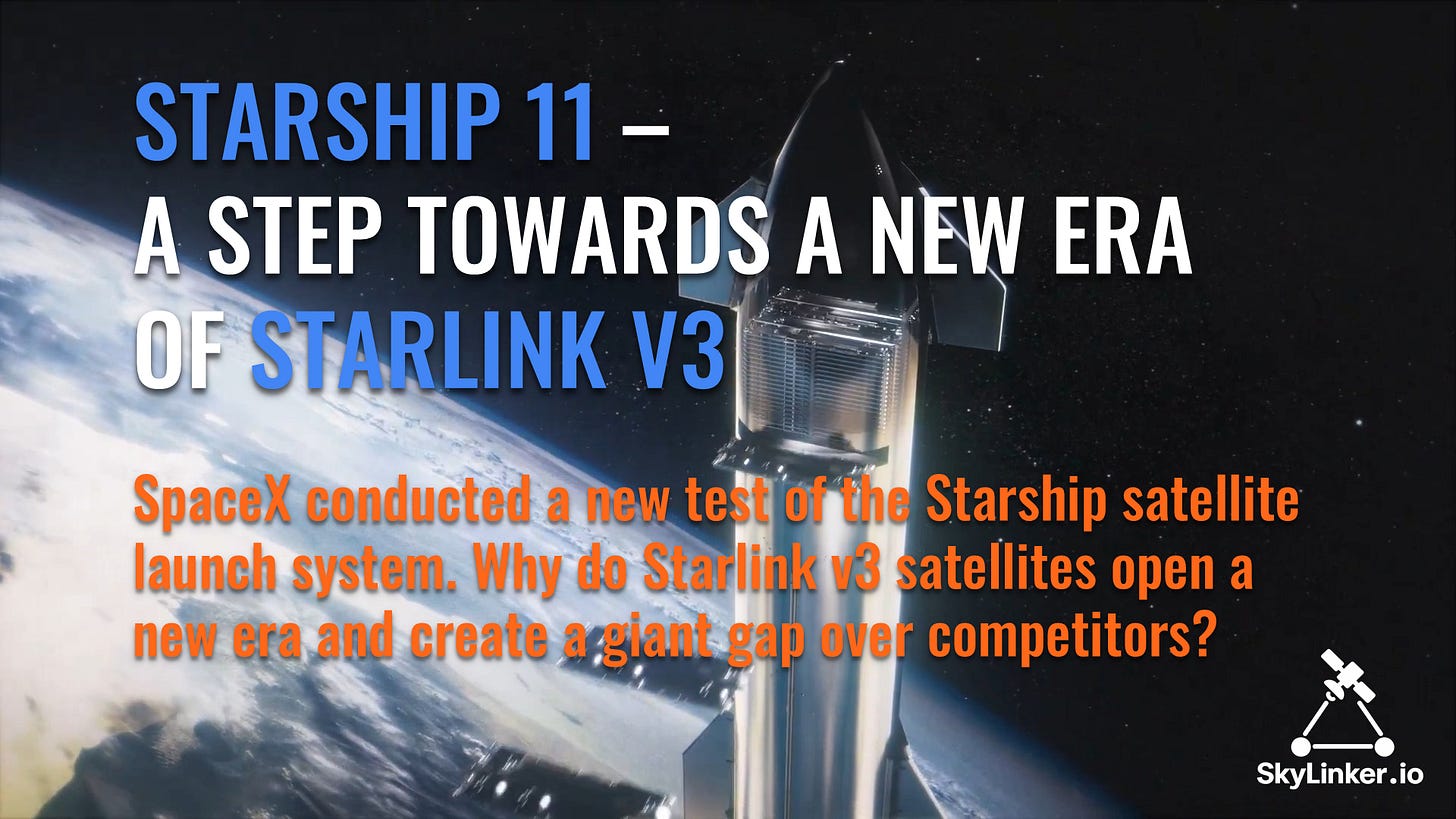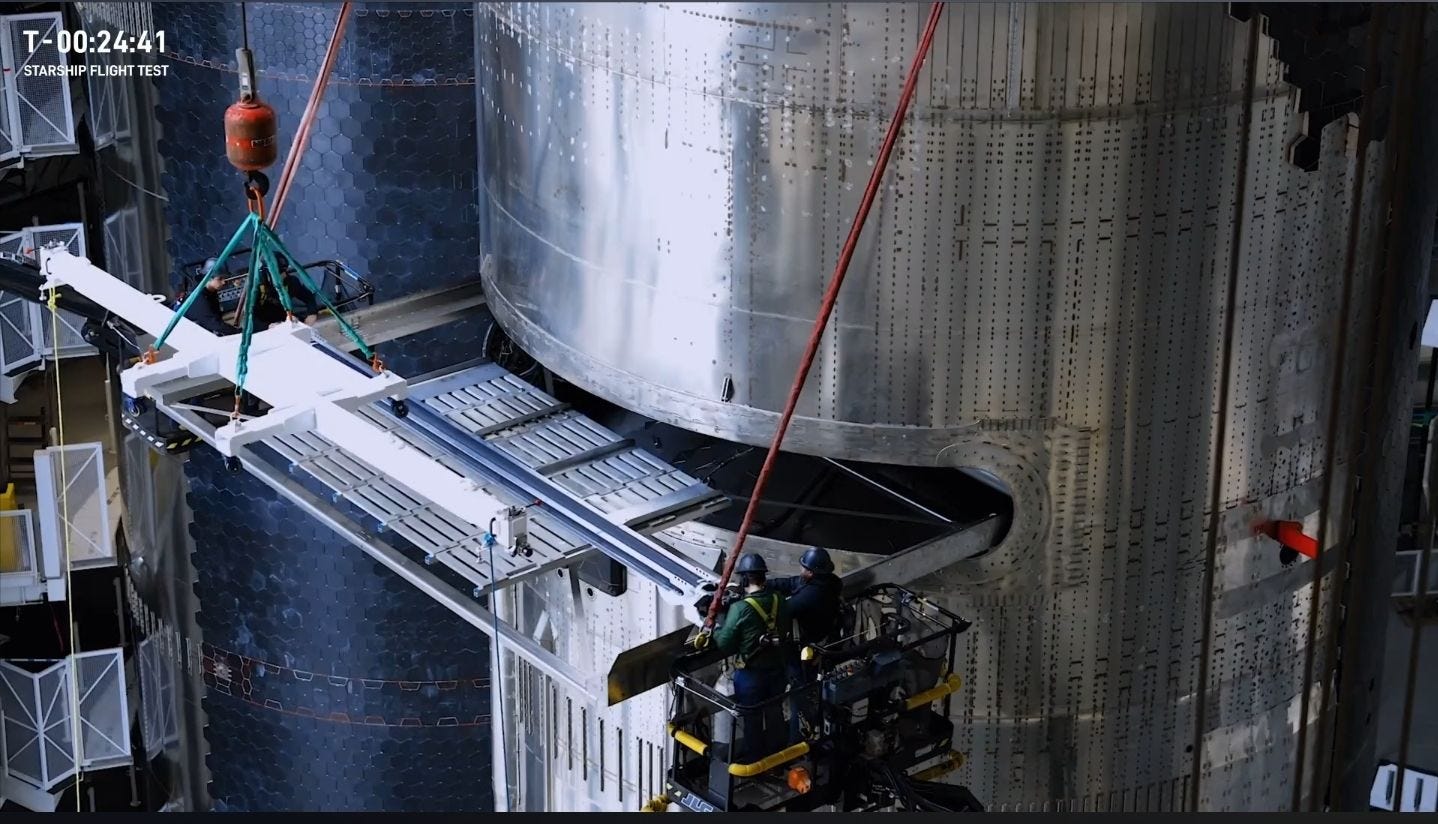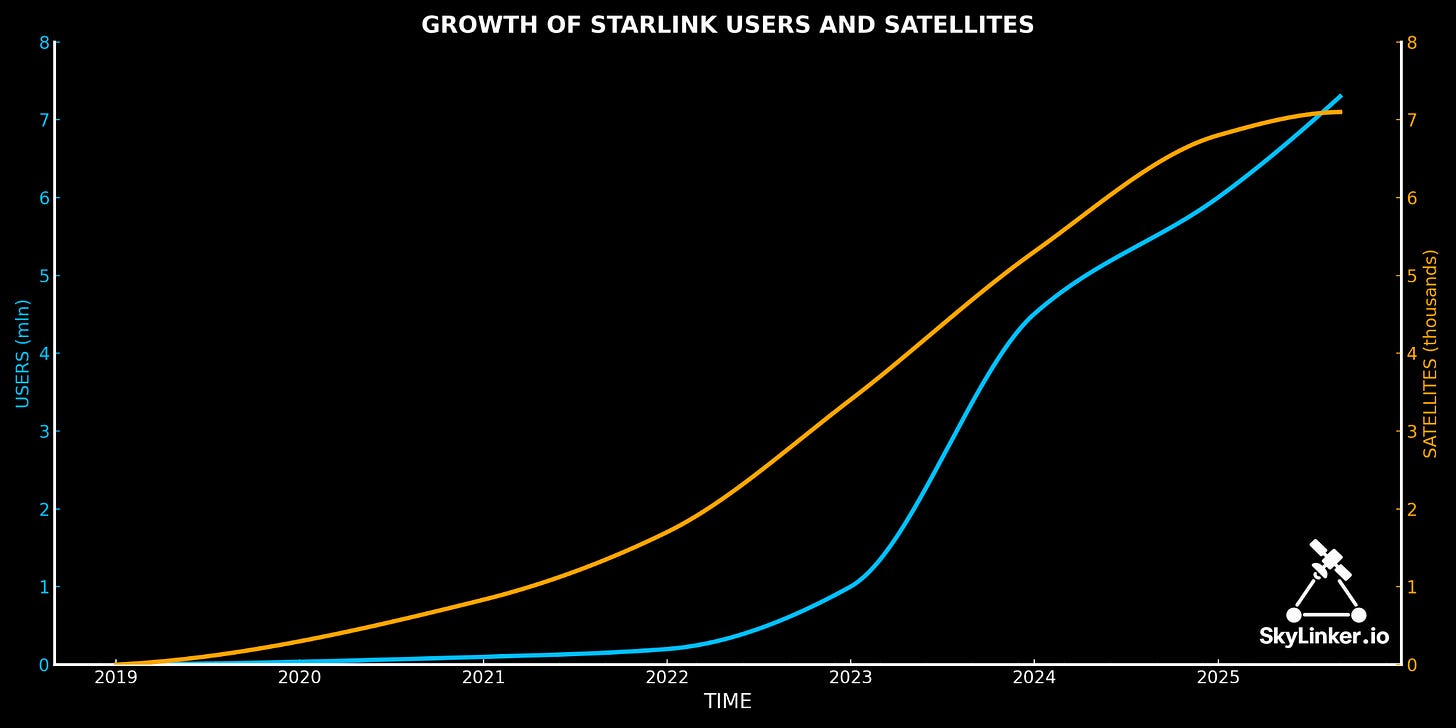Starship 11 – A Step Towards a New Era of Starlink v3
SpaceX conducted a new test of the satellite launch system using Starship. Why do the Starlink v3 satellites usher in a new era and create a massive lead over competitors?
On October 13, 2025, SpaceX carried out the eleventh Starship flight, and this time, the main test was neither the engines nor the heat shield. The main event took place after leaving the atmosphere: eight simulators of the new Starlink v3 satellites were deployed from the upper stage, Ship 38.
The previous test, Starship 10, saw the first trial of the satellite deployment mechanisms. In this flight, Starship 11 performed a more detailed practical testing of the deployment system for the next-generation Starlink network, which is expected to increase throughput tenfold.
The Test that Approaches a New Era
Starship launched from the Starbase (Texas) facility at 23:23 UTC. After separation, Booster B15-2 performed a controlled splashdown in the Gulf of Mexico, while Ship 38 executed a series of maneuvers, simulating a real orbital mission.
The key moment was the release of eight Starlink v3 mockups — mass and size simulators that replicate the shape, weight, and center of mass of the actual satellites. This allowed the SpaceX team to verify the behavior of the cargo bay, the deployment mechanisms, and the aerodynamics during object separation in microgravity.
According to engineers, this phase of the flight provided critical data for future orbital missions, when Starship will carry dozens of real v3 satellites for the first time.
What was tested this time:
Release mechanics — how the fairing opens, how the structure behaves at various separation angles.
Mass dynamics — whether the ship maintains stability after the sequential release of multiple objects.
Thermal conditions — how the compartment behaves after depressurization and object release.
Propulsion system — short RCS-engine pulses for correction after deployment.
All of this is not just a demonstration, but direct preparation for the launch of real v3 satellites, which are already being manufactured on the production line in Redmond.
Why This is Important
Starlink v3 — is a massive evolution of the entire network. Each new type of Starship launch will be able to deploy over 50 tons of cargo.
Currently, each Falcon 9 launch deploys 23-28 relatively light Starlink V2 Mini Optimized spacecraft into orbit. Each Starship launch will be able to deploy twice the number of satellites, but each such Starlink v3 belongs to a significantly higher category in both weight and capability.
Following Flight 11, SpaceX officially concludes the Block 2 series and transitions to Starship V3, featuring upgraded tanks, improved Raptor 3.5 engines, and a lighter airframe. This is the version slated to perform the first orbital launch of real Starlink v3 satellites in 2026.
Starlink v3 – What is Known About the New Satellite Generation
Starlink v3 will be the first full-fledged generation designed specifically for the capabilities of the Starship rocket. While the current V2 Mini Optimized, launched by Falcon 9, is an evolution within old limitations, v3 opens up a completely different scale for the network.
Today, Falcon 9 deploys 23-28 V2 Mini satellites per launch, each weighing about 730-760 kg. These spacecraft carry phased array antennas in the Ku- and Ka-bands, have a new power architecture with increased power (∼2.5 kW per transmitter), but are still limited by the volume and energy constraints of Falcon 9. Their orbital throughput is up to 80 Gbit/s, and inter-satellite laser communication is experimental, and only present on a portion of the batches.
Starlink v3 is designed completely differently. It is a scalable 2-ton class spacecraft, which can only be launched by Starship. The span of the solar panels is expected to double, the power system to increase by 3-4 times, and the total electrical power may exceed 10−12 kW. For comparison: this is the power level of a small medium-Earth-orbit telecom satellite.
The key difference is in channel capacity. While V2 Mini provides about 80 Gbit/s per user channel, v3 is designed for 1 Tbit/s for downlink and up to 160 Gbit/s for uplink. Together with a full inter-satellite laser link system (optical channels with a throughput of over 100 Gbit/s each), this yields a total network throughput of up to 4 Tbit/s per spacecraft.
It is also important that v3 uses a new antenna architecture — fully digital phased arrays with dynamic beamforming. They allow for “illuminating” dozens of targets simultaneously, flexibly distributing power among users. The number of beams per satellite is expected to increase from ∼5,000 in V2 Mini to over 15,000 in V3, which will sharply increase spectral efficiency.
Another radical change is the inter-satellite communication system. While V2 Mini used experimental laser modules, v3 will receive a full-fledged LEO-mesh architecture: each spacecraft will be able to exchange data with four neighbors, creating an orbital backbone independent of ground stations. This will allow traffic to be transmitted across continents without intermediate routing through gateways.
Thanks to greater power and more efficient antennas, v3 is expected to be able to reduce signal latency to <20 ms, and terminal throughput to several gigabits/s for corporate and military users.
All of this requires a new class of launch vehicle. This is why Starship will become the only means of delivering such satellites: one launch will be able to carry 50−60 v3 spacecraft, adding over 60 Tbit/s of network capacity at once. This is more than the entire first phase of Starlink had in total in 2021.
Thus, Starlink v3 is not just a bigger satellite. It is a change in the network architecture itself: a full orbital support mesh, scaled like a data center in space. V2 Mini closes the expansion stage; v3 opens the integration stage, where Starship and Starlink transform into a unified global communication platform.
Why the Transition to Starship and Starlink v3 Creates an Unbridgeable Gap
When Starlink transitions to launching v3 satellites with Starship, the balance of power in the entire industry will shift dramatically. The reason is simple — scale. One Starship launch is capable of deploying as much throughput as a dozen Falcon 9 launches, and doing so at a lower cost.
Where competitors are still counting every launch, SpaceX will gain the ability to deploy the network at a pace that no one can replicate.
Starship opens up not only greater volume but also a new launch economy. Full reusability means that the cost of orbital placement drops to a minimum. If delivering a kilogram to orbit costs thousands of dollars today, in Starship missions, it will be dozens or hundreds. And this difference is not theoretical — it determines who can afford thousands of spacecraft and who cannot.
The Starlink v3 satellites themselves change the essence of the system. Their throughput significantly exceeds V2 Mini, and the new architecture with laser inter-satellite links allows data transmission without being tied to ground stations. As a result, SpaceX gains an orbital communication backbone that operates independently of the infrastructure on Earth.
Competitors — OneWeb, Kuiper, Telesat — remain within the traditional model: expensive launches, limited mass, slow deployment. Starship + v3 take Starlink outside this logic. From now on, network development will be measured in terabits of new throughput per month, not in the number of launches.
This is not a short “breakthrough,” but a change in scale that is almost impossible to catch up with. SpaceX is getting a system that develops exponentially, while everyone else moves linearly. And that is why the gap, which will begin with the first real v3 launches, will become a long-term asymmetry for years to come.




